Nurse Logs
By John Palka — Posted April 8, 2017
Take a walk in the ancient forests of the Pacific Northwest and you will probably come across trees literally growing on trees, as in this photograph taken in the Hoh River area of Olympic National Park.
It’s a dramatic sight, sometimes with almost mythic overtones. But what is going on, really, and why?
New generations in the forest
The forest is a highly dynamic system, with generations of plants and other organisms living, dying, and being replaced all the time. It is also a very competitive system, with many resources that are essential for life being in short supply. These include, among others, sunlight, moisture, nutrients, and places for the next generation of trees to sprout. It seems that fallen and decaying trees can sometimes provide resources such as these in greater abundance than does the forest floor, so they are preferred germination areas for new trees and shrubs. Once germinated, the seedlings find that these logs continue to provide a favorable substrate for further growth. We call such logs nurse logs.
How might this work? Imagine that you are a tiny seed, one among the millions and millions shed each year by the mature trees of the forest. You come drifting down from where you were released by a cone, tens or hundreds of feet up in the air. Below you, the forest floor is covered with ferns, mosses, and green shrubs, and before you even get to the floor your way is partly blocked by the myriad needles of the evergreen trees that comprise the forest. Your chances of landing on a bit of exposed soil, which is what you need for germination, are not great, and your chances of landing where there is adequate light for germination and growth are even less.
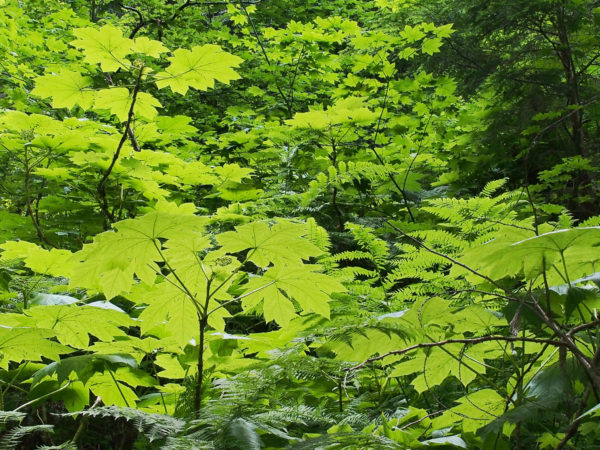
Dense understory along the Thunder Creek Trail in the North Cascades of Washington. The large leaves are devil’s club (Oplopanax horridus). Also present are vine maple (Acer circinatus), sword fern (Polystichum munitum), and other species
But look, there is a huge trunk lying on the forest floor. It’s cracked in a few places from the impact of its fall, and a third of it is covered with the branches that form its crown, but there is easily fifty feet or more of trunk that is open, rising gently above the surrounding ferns and other vegetation, and perhaps covered with mosses and lichens. It’s a fine surface to land on so long as those mosses and lichens are not too tall (around two inches seems to be the limit), and might even provide exposure to the rare sunshine of the forest floor. If you had the means to steer on the breeze, surely this is a spot you would aim for! In reality, of course, you can’t steer. On the other hand, you are not alone, and those of your innumerable kin who happen to land on this nurse log will get a head start in life. In this way, the exposure of a potential germination and growth surface can lead to its colonization by trees and shrubs.

A moss-covered nurse log in the Hoh River area of Olympic National Park. The tree seedlings are almost certainly those of Sitka spruce and/or western hemlock. The broad-leaved seedling is salal (Gaultheria shallon).
Above you see a nurse log serving as a nursery for recently germinated seedlings. Below you see forest regeneration on a nurse log at a considerably more advanced stage.
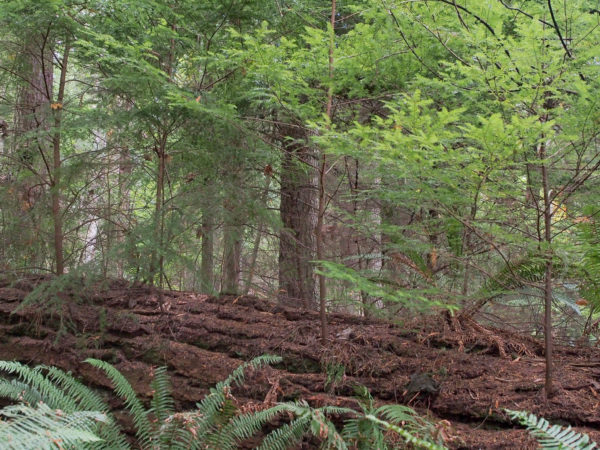
Young western hemlock growing on a fallen Douglas fir (Pseudotsuga menzesii). In the foreground are sword ferns. Taken along the Hoypus Trail in Deception Pass State Park, Washington.
What are nurse logs like?
Let’s accept for the moment that fallen logs can support new growth—effectively the regeneration of the forest—and look briefly at some of their attributes.
- Their size. The coastal rainforest of western North America—from the redwoods of central California; through the Douglas firs, cedars, and hemlocks of Oregon, Washington and British Columbia; and on to the Sitka spruce of Alaska—is noted for the enormous size and great age of its trees. Old trees are often several feet thick. Thus, when a trunk falls its surface rises above the ferns and other undergrowth to provide a landing and growth surface that is not shaded and thus is available for germination and growth. Extreme trunk thickness is not, however, a requirement for nurse logs to be effective. In other forests—both temperate and tropical, and even at timberline—trunks of more modest dimensions function effectively as growth substrates for forest regeneration.
- Their decay. Decaying wood is a good substrate for growth. Intact wood is not—it is too hard for roots to penetrate, and the cellulose and lignin of which it is largely composed are not readily available as nutrients to the seedlings. Some fallen trees were dead snags even before they fell, and they had already been subjected to attack by fungi, insects, and other decay-promoting organisms. Such trees may already be ready to serve as nurse longs. Others were brought to the ground while still alive and healthy, their trunks uprooted or perhaps snapped by a fierce storm. Once decay starts, they too can become effective nurse logs.
- Their age. Mature forests contain trees of a wide variety of ages, and fallen trees are correspondingly diverse. How does this bear on the number of years that a decaying nurse log will remain more or less intact? An often-cited rule of thumb is that a tree takes as long to decay as it took to grow before it fell. Thus, trees that are hundreds of years old will take hundreds of years to decay. This means that nurse logs formed by old trees will remain available as a substrate for growth for all those hundreds of years, and the new generation of trees will already be old before their nurse logs vanish into the soil of the forest floor.
Below we see an enormous nurse log with young trees on the top and roots growing over its surface to reach the ground below. This is typical. Seedlings sprout and start their growth on the surface of the log, but in addition to roots that penetrate the log they send out others that become anchored in the soil below.

A giant Douglas fir nurse log on the Wilbert Trail in South Whidbey State Park in Washington. The western hemlocks growing on its upper surface are sending down roots into the adjacent soil.
In the following photograph you can see this process on the way to completion. The nurse log is now hard to see because it is significantly decayed and is covered by the roots of the new tree. This tree, a western hemlock, has grown to be massive. You can visualize the culmination of the growth of the new and the decay of the old—the nurse log will disintegrate completely, and the new tree will be left standing on stilt-like roots with nothing but air where the nurse log used to be.
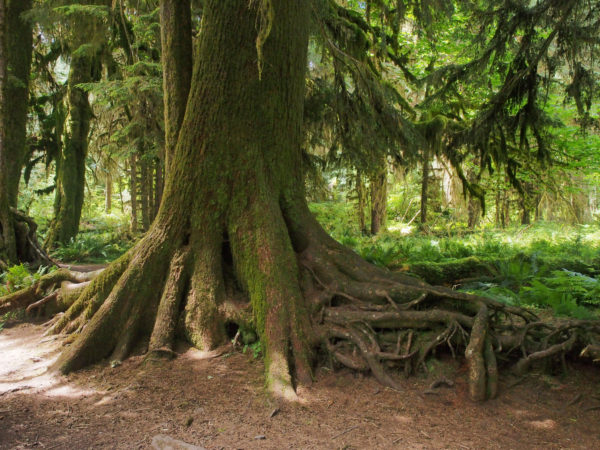
A well-established western hemlock on stilts over its nurse log. This is a later stage in the process illustrated in the previous photograph. Hoh River Valley, Olympic National Park.
Nurse logs play an important role in the constant renewal that prevails in a healthy forest. They do this because they provide a growth substrate that is different from the rest of the forest floor, so they increase the diversity of habitats for the new generation of trees. Sometimes this significantly increases the diversity of plant species comprising the forest. In the coastal forests of Washington, for example, it has been reported that as much as 90% of the new population of Sitka spruce and western hemlock are found on nurse logs, whereas alder (Alnus rubra), bigleaf maple (Acer macrophyllum), western red cedar (Thuja plicata) and, in slightly drier regions, Douglas fir prefer the soil of the forest floor. Thus, when both substrates are available, species diversity is promoted. In other forests this is not the case, and all tree species are represented on both nurse logs and the forest floor in more or less equal proportions.
Why are nurse logs so effective?
What might be some factors that govern whether nurse logs offer a substrate with specific advantages over soil? The answer is not obvious, because soil is a more nutritious growth medium than is wood, even decaying wood. Here are some suggestions that have been made.
- There is simply more exposed surface for seeds to land on, especially if lichens and mosses have not yet covered a log.
- Increased exposure to light can be very important.
- Given continuous leaf- and needle-fall, seedlings on rounded nurse log surfaces may be less prone to being smothered than seedlings on flat ground.
- The moisture available to the roots of seedlings may be more consistent. The surface layers of soil can dry out very quickly, whereas the trunk of a fallen tree, especially a decaying one, may be able to provide a reservoir of moisture.
- The temperature regime may be more favorable.
- And, most recently, there is interesting evidence that nurse logs may provide protection against soil-borne pathogens that kill off seeds or seedlings.
At first glance this last suggestion seems a bit odd, because the main pathogens in question are fungi, and fungi are also the main agents of decay in wood and so should be extra-abundant in rotting nurse logs. However, the fungi that cause wood rot are quite different from those that kill seeds and seedlings, so the hypothesis is plausible.
Here is some direct evidence that nurse logs do provide protection against fungal infection for the next generation, based on a study of eastern hemlock (Tsuga canadensis) conducted in a forest in Ontario, Canada. The investigators selected a number of fallen and decaying logs in the forest and adjacent to them outlined plots of soil of comparable size and shape. They planted equal numbers of seeds on the logs and in the soil plots. The experimental manipulation was to treat the seeds with a carefully selected fungicide.
The most dramatic single result was this: applying fungicide substantially increased the germination and survival of seedlings in the soil, but had no effect on seedlings growing on the nurse logs. Evidently, the soil contained fungal pathogens that could be eliminated by the fungicide, while the logs in one way or another provided a refuge from fungal pathogens that was as effective as the externally applied fungicide.
Nurse logs in a dynamic context
Many, many studies attest to the fact the nurse logs are important in forest regeneration. They are especially spectacular in temperate coastal rain forests, but they have been found from sea level to timberline and from the tropics to the boreal forests of the far North. Traces have even been seen in petrified forests in Argentina, in trees that grew around 300 million years ago when the continents were not even separated as we know them today but were sutured edge-to-edge in a mass called Gondwanaland.
When we look at nurse logs, we see the process of forest evolution from generation to generation captured in a moment of time. The next time you take a walk in the forest, look at the nurse logs with an awareness of the role they play over years, decades, centuries, and millenia—as long as the forest persists.
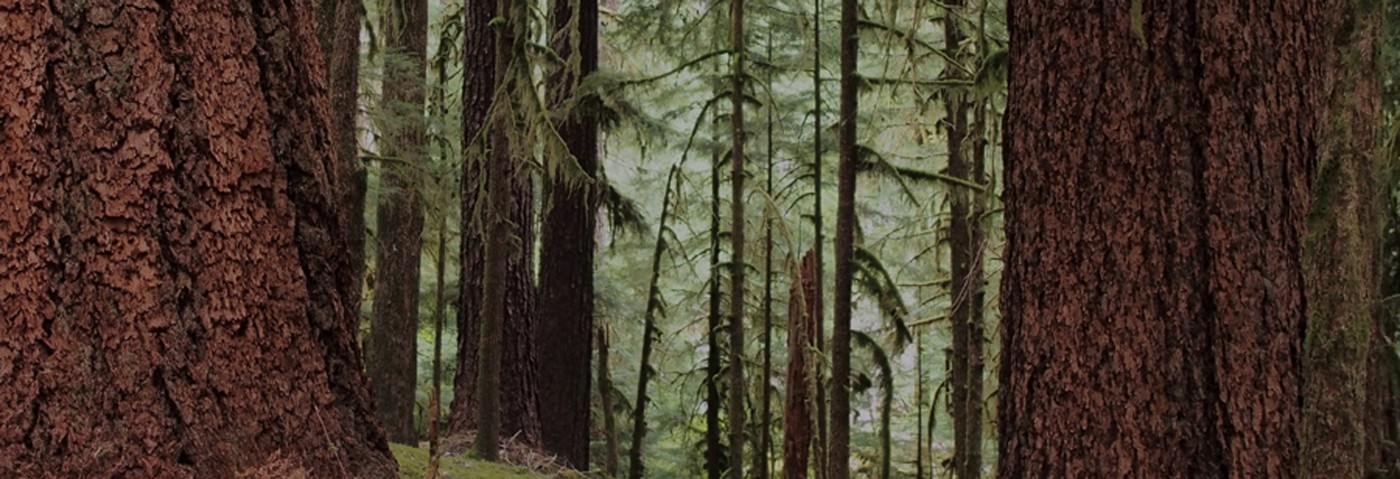
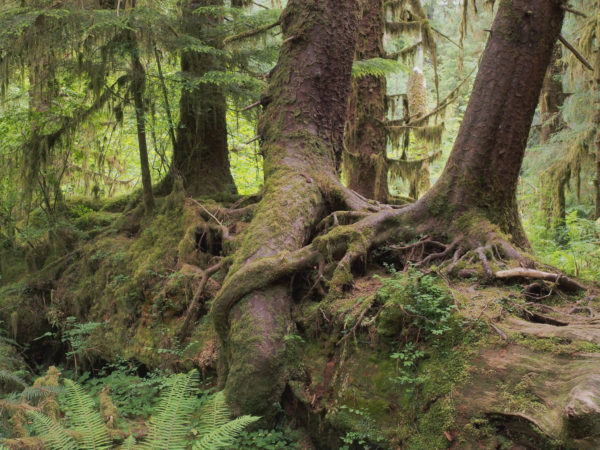
I’ve been thinking about the theme of resurrection as we approach the Easter season and this seems to be another natural, non-supernatural way of looking at how life and ideas live on despite death and tragedy. Thanks, Johnny!
That’s a very evocative perspective, Kit. Thanks for bringing it forward.
Great article! And since i live in northern Ontario, the experiment involving fungicides was of particular interest. I’m off to share this on facebook — already put a link to your blog on mine.
Thanks for your appreciative note, Gary. Here’s the reference to the fungicide study: D.L.O’Hanlon-Manners and P.M. Kotanen, Logs as refuges from fungal pathogens for seeds of eastern hemlock (Tsuga canadensis). Ecology 85 (1), 2004, pp. 284-289. Of course, Ecology is a professional journal and you may not have free access to it unless you are affiliated with a university or other research institution, subscribe to JSTOR.
Loved it..! The ‘nurse log’ was the first amazing new learning of my transplantation to the NW… The forestry experience of the prior decade somehow missed this concept!! Many fabulous beauties have followed … as usual you offer marvelous insights..!
Thanks, Marty. I, too, remember nurse logs as one of my first Northwestern learnings. But oh my, what a long time ago that was!
Fascinating! I realize I have seen situations similar to that in the last photograph but not realized how they came about. I will keep my eyes open for the nurse logs from now on.
Yes, Mother Nature doesn’t tell all her stories of her own accord. Sometimes you have to ask!
Beautiful pictures and great writing- makes me miss you!
Thanks, Sweetheart!
Fabulous article and wonderful pictures, Johnny. Thank you! :o)
Thanks, Julie!
As a teenager growing up in Montana I often rode with a girlfriend into the woods. At a midway point in dense timber we would stop an rest for a while and possibly sit on a fallen log. It was a opportunity to be alone and close to your girl. It was known by the adults as “rotten logging”. Coming home you were always met with knowing smiles from the elders.
Your “nurse log”essay explains the marvelous composting, nurturing process constantly in progress in our wonderful forests. thank you , Johnny
What a wonderful story. May we never stop doing rotten logging!
I have valued nurse logs since, as a teenager, first hearing about them from a park ranger near Lake Tahoe, CA. Your article has deepened my understanding and appreciation for them. On my land, one of my favorite trees is an alder, several feet in diameter that sits on stilts 3-4 feet high, with no trace of what I assume was a nurse stump. Thank you, for this post!
Thanks, Marc. Your comment is the first time I have heard of an alder evidently growing on a nurse log. You learn something every day!
I think this is one of your best, Johnny!
So I have a question. You have a great image of a root making its way down the side of a nurse log for several feet in open air. If this were a tropical forest with vines or Banyan trees, I might think the root had simply slithered down the side of the log. But I doubt it in this case. My guess is that the root in the Wilbert Trail photo actually made its way down beneath the bark before it peeled off, rather than being “sent” down through thin air. What do you think?
Thanks, Larry. I struggled with this post a lot, as indeed I do with most of them! As for the root, you may well be right. On the other hand, if you look further right in the same picture, you see a whole bundle of thinner roots slithering, as you so well put it, first over remaining bark and then over bare wood. So, both processes seem possible. I have no better answer than that.
I’m just curious if the resulting tree, once the nurse log or stump has completely decayed, is at greater risk of ‘blow-down’, or if the exposed ‘stilt-like’ roots are just as strong as any others? Thanks
This is an interesting question. I am not aware of any data on the point, though there may well be some. I can say that I have seen many trees, especially western hemlocks, standing tall on their stilts. From this it would seem that they are not especially fragile. However, it would take a quantitative analysis to detect an enhanced susceptibility to blow-down, and that I cannot offer you. If I come across such data, I will post them here.
I suspect it depends on their particular configuration. Some that root in high standing stumps, which subsequently rot away, could well suffer earlier tumbles. But I have seen many that rooted on fallen logs that seem firmly rooted, especially where debris builds up around the crumbling log. One piece of suggestive evidence is that I, anyway, have never seen a truly old tree, hemlock or otherwise, that is still standing on obviously exposed roots that might have begun in a high stump rather than a log. On the other hand I have seen ancient hemlocks rooted on the remains of logs. In one case, possibly on several. Those roots are amazingly tenacious.
Thanks, Larry!
A wonderful and informative post. Thank you for sharing.
Hi there, I looked up nurse logs as a result of reading Overstory. It’s an incredible novel about trees. I’ve made so many notes of things to look up. I enjoyed your article and as I grew up in the Great Northwest, I’ve seen many examples of these, esp in the Hoh. Thanks for taking me back and for providing the name for this wonder.
It’s always great when a post has personal meaning for a reader. Thanks for letting me know!
What do you call the tree that grows out of the nurse log? Is there a term for that?
I’m not aware of any such term, Heidi. Perhaps that’s because a variety of plants grow on nurse logs, not just trees. Some others include a variety of shrubs like evergreen huckleberry, ferns, and the ubiquitous mosses. Of course, there could be a collective term, but I don’t remember ever seeing one. Perhaps someone else has.
Great article. Is there a TERM for the new trees that grow in/out of the nurse logs/stumps? I’ve been looking, and all I’ve come across is “regenerative.”
Thanks, Roni. I am not aware of any specific term for the new trees/shrubs/ferns that grow on nurse logs that would correspond to the term”nurse log” itself. It’s a good question that I never thought about before!
What species of fungi and other plants grow on nurse logs, especially western red cedar?
In my experience, most fungi grow inside, often deposited by bark beetles and other insects, not “on” nurse logs. Mostly they are covered with a variety of mosses (different species on different parts of the log) which, in turn, provide a moist and welcoming substrate for the seeds of vascular plants like hemlock or huckleberry whose roots make their way under the peeling bark to reach the soil. Lichens also appear on the bark, though most often simply because they were on the tree before it fell.
Hi, Larry! Many thanks for such a detailed and vivid response!